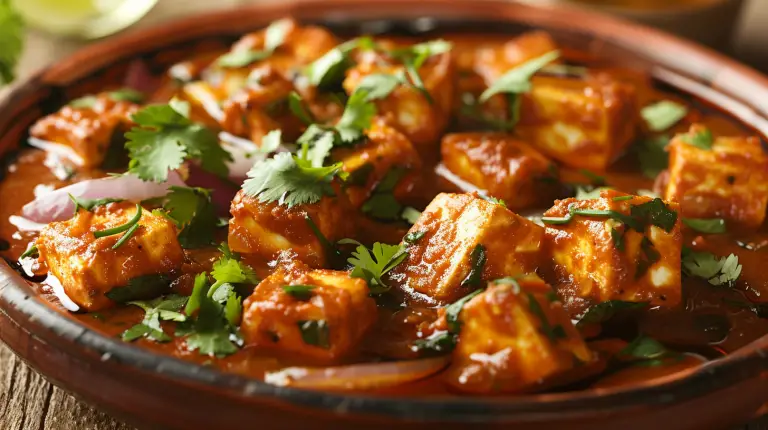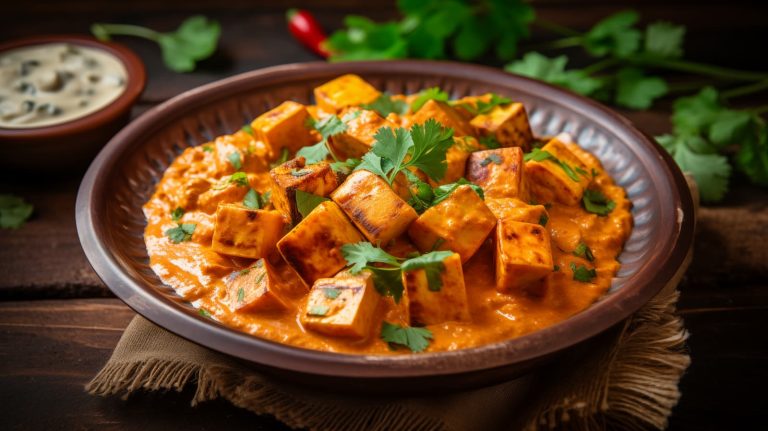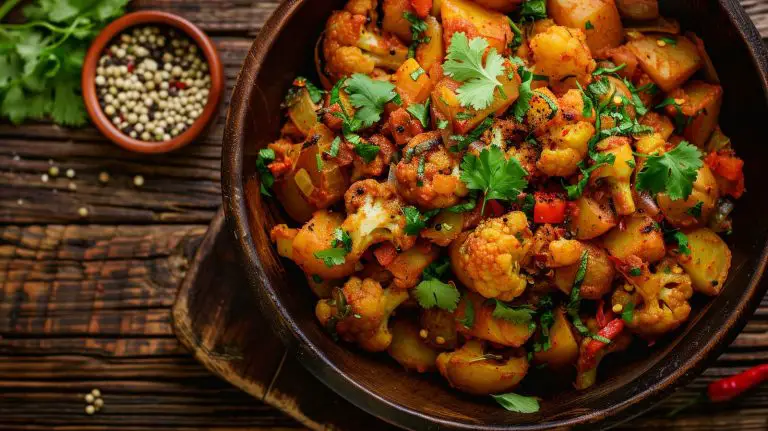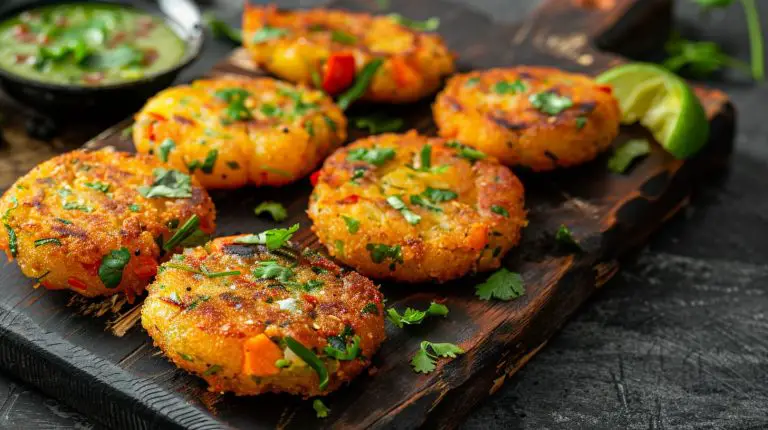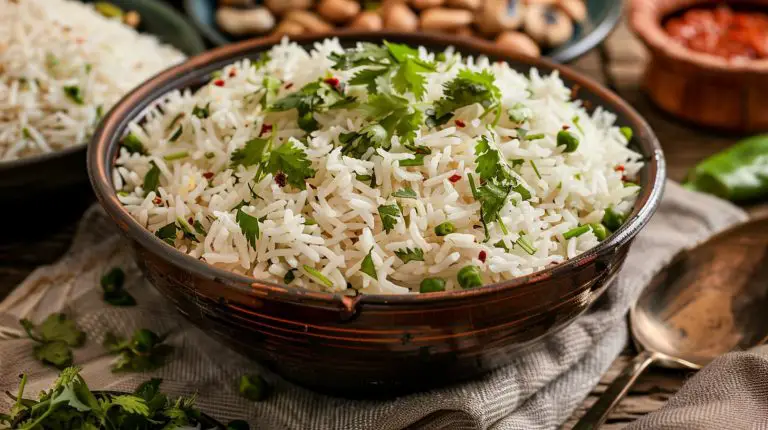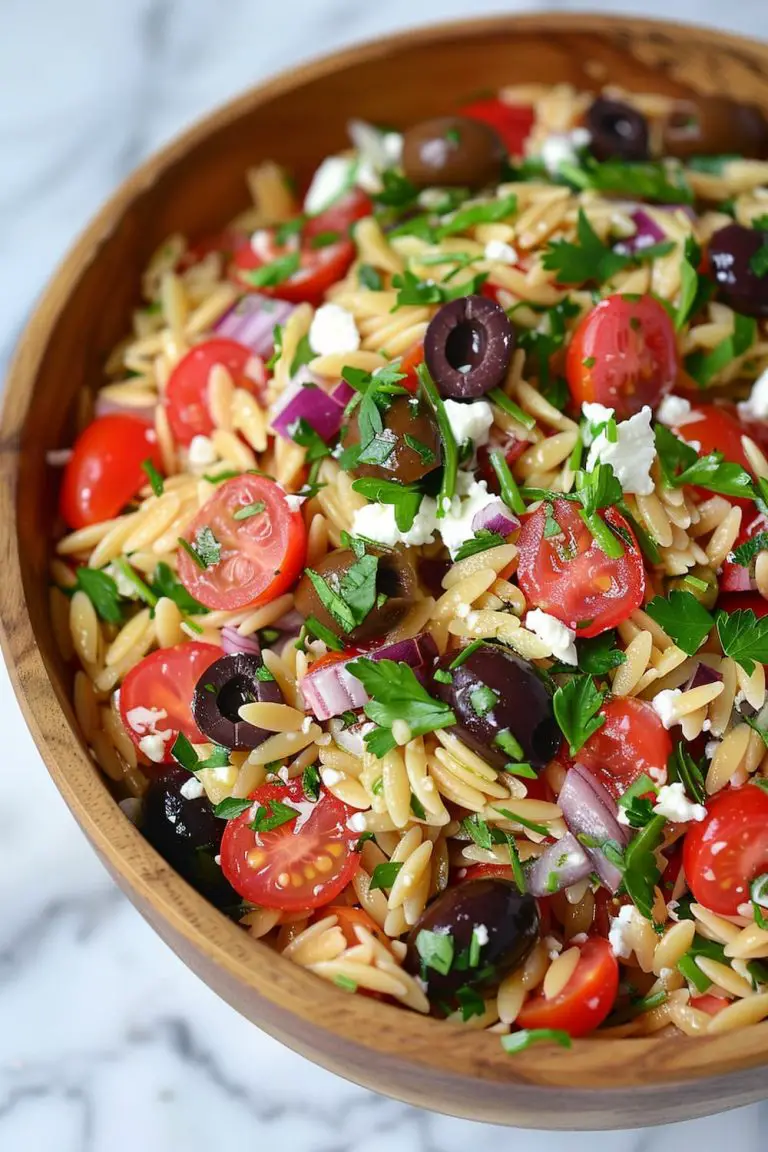Chickpea Tikka Masala Step By Step Recipe
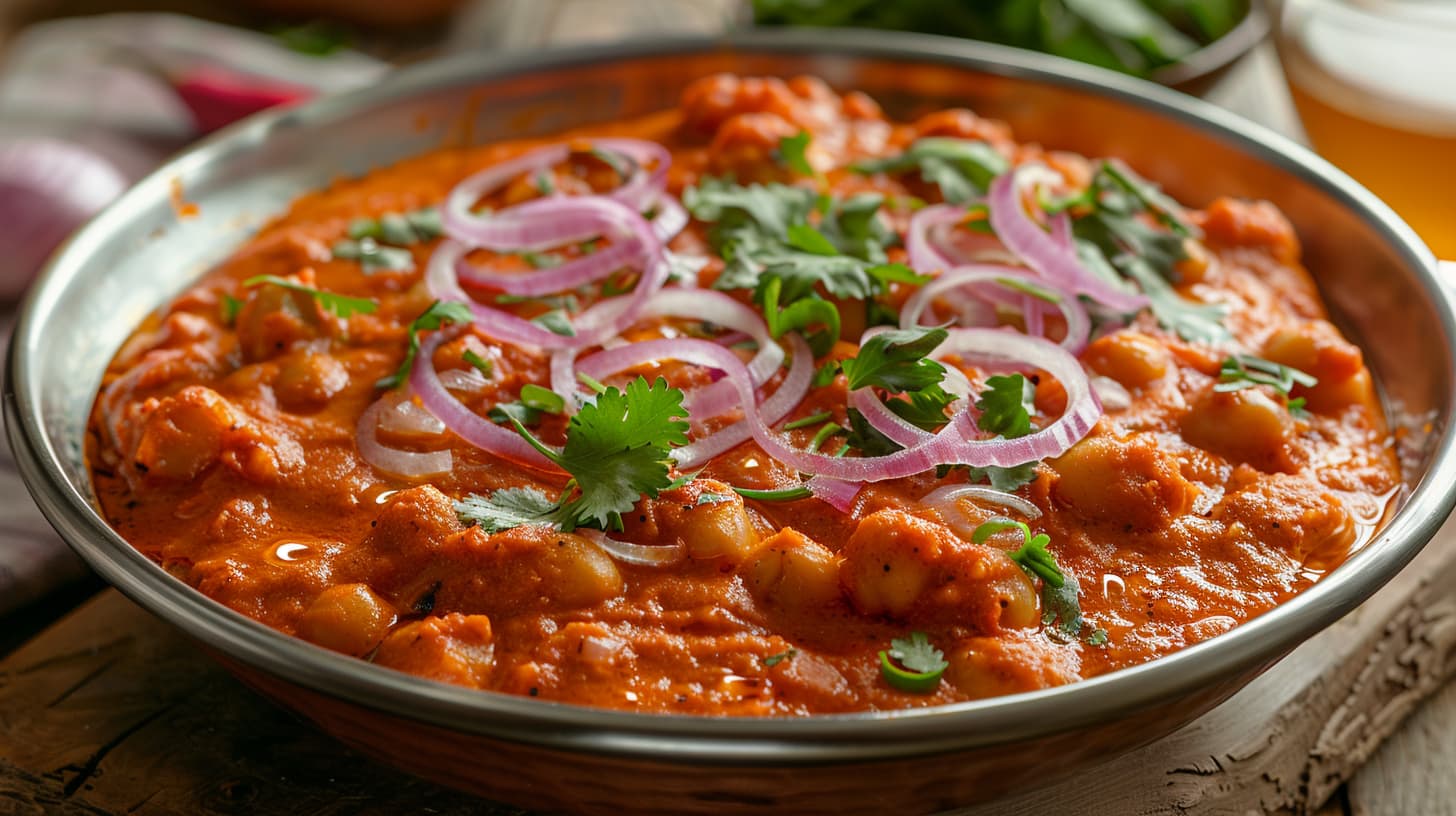
Did you know that “Tikka Masala,” often associated with Indian cuisine, was popularized in the UK? My rendition of, Chickpea Tikka Masala, offers a vegetarian twist on this beloved classic, proving that great flavor knows no boundaries.
In just 40 minutes, and with simple ingredients, you can create an authentic Indian masterpiece right in your kitchen.
- The term “Masala” in Hindi translates to “a blend of spices,” highlighting the dish’s primary ingredient or cooking method.
- Despite regional variations, such as the addition of cream in the North and coconut milk in the South, the core essence of Chickpea Tikka Masala remains unchanged: a hearty, spiced, tomato-based curry that warms the soul.
Why You’ll Love This Recipe:
- Healthy and Hearty: Packed with protein-rich chickpeas and a rainbow of spices that boast numerous health benefits.
- Weeknight-Friendly: Simple enough for a weeknight dinner, yet impressive enough for entertaining guests and family.
- Versatile and Customizable: Easily adaptable to suit your taste or whatever you have on hand.
- Aromatic Journey: Bring the exotic flavors of Indian cuisine into your kitchen, making dinner an adventure.
In this guide, you’ll learn
- How to make mouth-watering Chickpea Tikka Masala in your kitchen
- Common Mistakes To Avoid, Pro Tips To Enhance The Taste Of the Dish
- FAQs (Reader Questions Answered) and much more stuff!
So, grab your apron, and let’s dive in!
How to make Restuarant Style Chickpea Tikka Masala At Home As A Beginner
Chickpea Tikka Masala for Four
Preparation Time: 20 minutes Cooking Time: 40 minutes Total Time: 60 minutes
Ingredients for Chickpea Tikka Masala:
Chickpeas:
- 200 g (about 1 cup) dried chickpeas (Alternative: soak and cook 400-425 g chickpeas for the equivalent of 2 cans (15 oz each) chickpeas)
Spice Base:
- 30 ml (2 tablespoons) olive oil (Alternative: any vegetable oil)
- 1 large onion, finely chopped (about 150 g)
- 3 cloves garlic, minced (about 9 g)
- 2.5 cm (1 inch) ginger, grated (about 10 g)
- 400 g (about 14 oz) fresh tomatoes, pureed (Alternative: 1 can (14 oz) crushed tomatoes)
- 400 ml (about 14 oz) full-fat coconut milk (Alternative: 400 ml dairy cream for non-vegan version; for a raw alternative, blend 200 g soaked raw cashews with water)
- 15 g (1 tablespoon) garam masala
- 5 g (1 teaspoon) turmeric powder
- 5 g (1 teaspoon) cumin powder
- 2.5 g (½ teaspoon) chili powder (Adjust to taste)
- Salt to taste (start with 1 tsp and adjust)
Garnish and Serving:
- Fresh cilantro, chopped, for garnish
- Lemon wedges, for serving
- Rice or naan bread, for serving (For a raw alternative to rice, consider cauliflower rice; for gluten-free, ensure naan or bread meets dietary needs)
Preparation Notes:
- Chickpeas: Soak the dried chickpeas overnight in plenty of water. Drain and rinse, then cook in fresh water for 1-2 hours or until tender. This method not only enhances their texture and flavor but also makes them more digestible.
- Tomatoes: For the freshest sauce, choose ripe tomatoes, blend until smooth, and use in place of canned crushed tomatoes. The freshness of the tomatoes can significantly impact the depth of flavor in your masala sauce.
- Coconut Milk: If using a raw alternative, blending soaked cashews with water until smooth can create a rich, creamy base that mimics the texture and consistency of traditional coconut milk or cream.
Instructions:
If Using Dried Chickpeas:
- Soak Overnight: Rinse the dried chickpeas under cold water to remove any debris. Then, soak them in a large bowl of water overnight.
This is not just a step; it’s a transformation, as the chickpeas absorb the water and begin to soften.
- Cook the Chickpeas: Drain and rinse the soaked chickpeas. Transfer them to a large pot and cover them with fresh water, about 2 inches above the chickpeas.
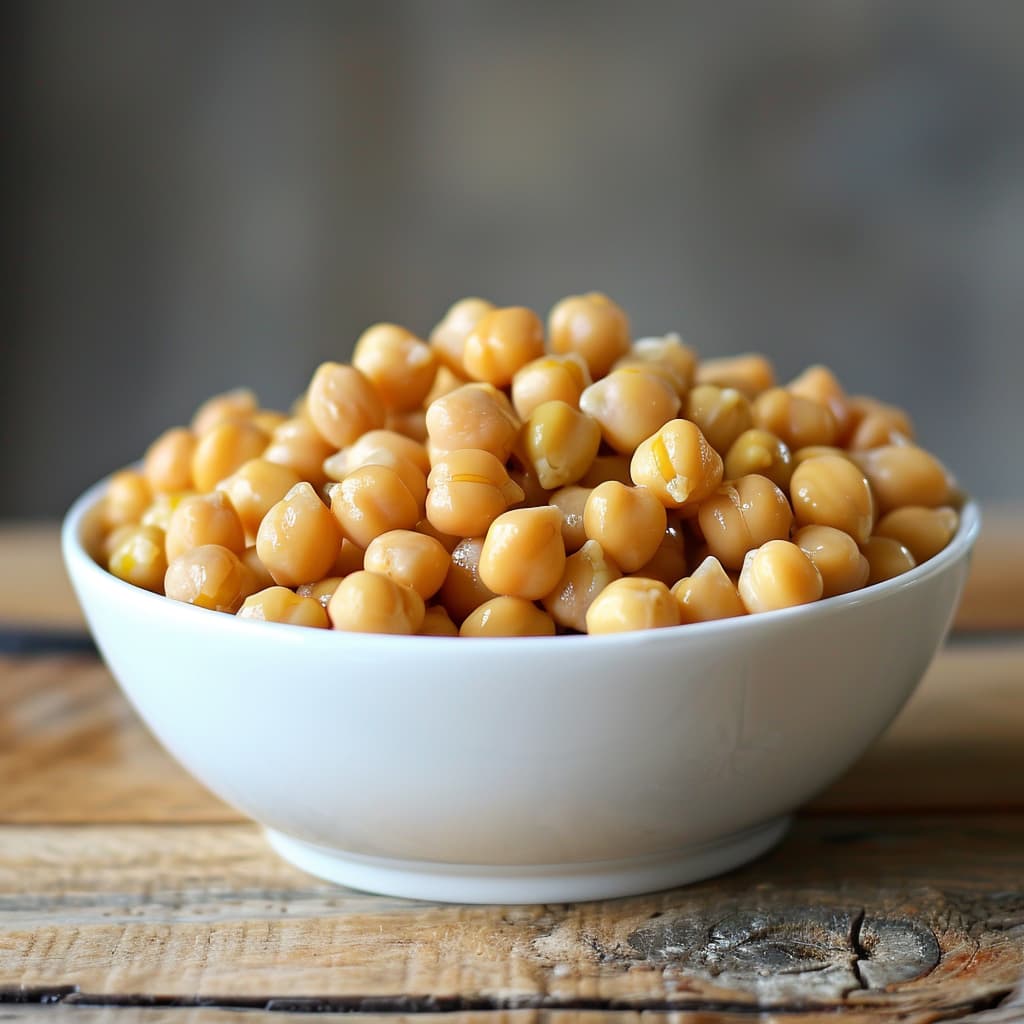
Bring to a boil, then reduce the heat and simmer for 1-2 hours, or until the chickpeas are tender. The journey from hard beans to soft, plump chickpeas is slow but rewarding. They’re ready when you can easily mash them between your fingers.
Once the chickpeas are cooked and tender, drain them and set them aside.
Prep the Base:
-
- Heat oil in a large pan over medium heat.
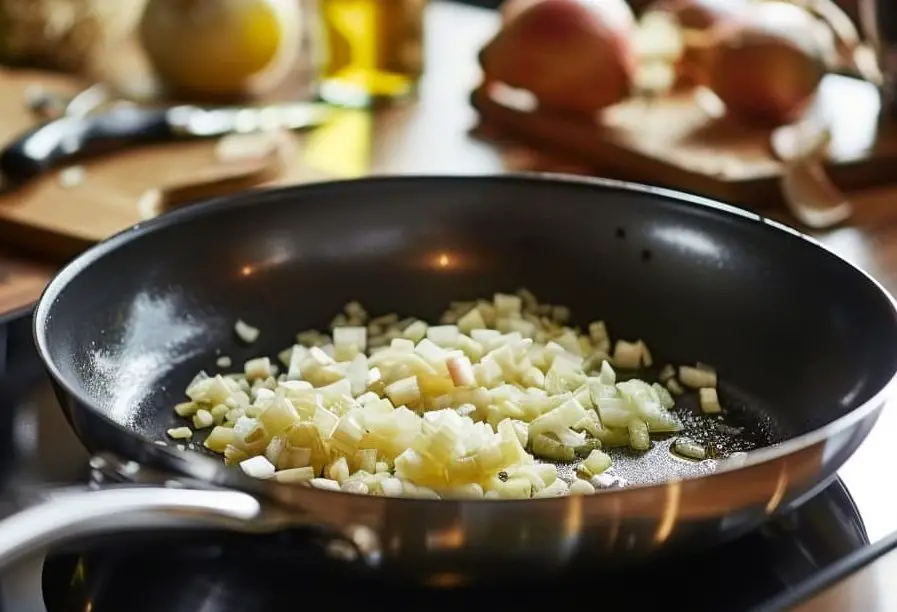
- Add the chopped onion, sautéing until it turns translucent and slightly golden. This is where the foundation of flavor begins.
Aromatics Unleashed:
-
- Stir in minced garlic and grated ginger to the onion mixture.
- Sauté for another minute until the aroma fills your kitchen.
Spice Symphony:
-
- Sprinkle in the garam masala, turmeric, cumin, and chili powder.
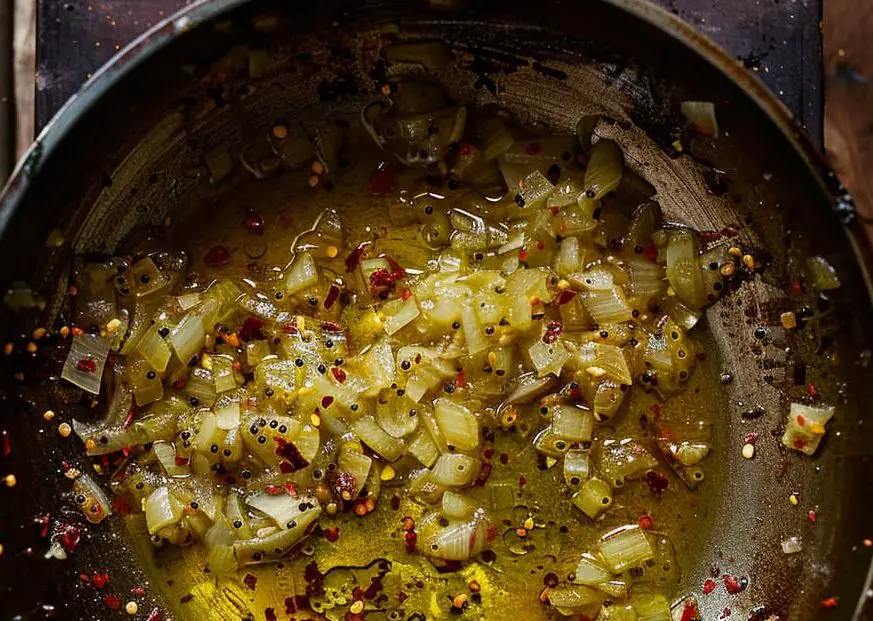
- Stir continuously for about 30 seconds. Toasting the spices this way releases their oils, magnifying their flavors and marrying them beautifully with the aromatics.
Simmering the Sauce:
-
- Pour in the crushed tomatoes and add salt.
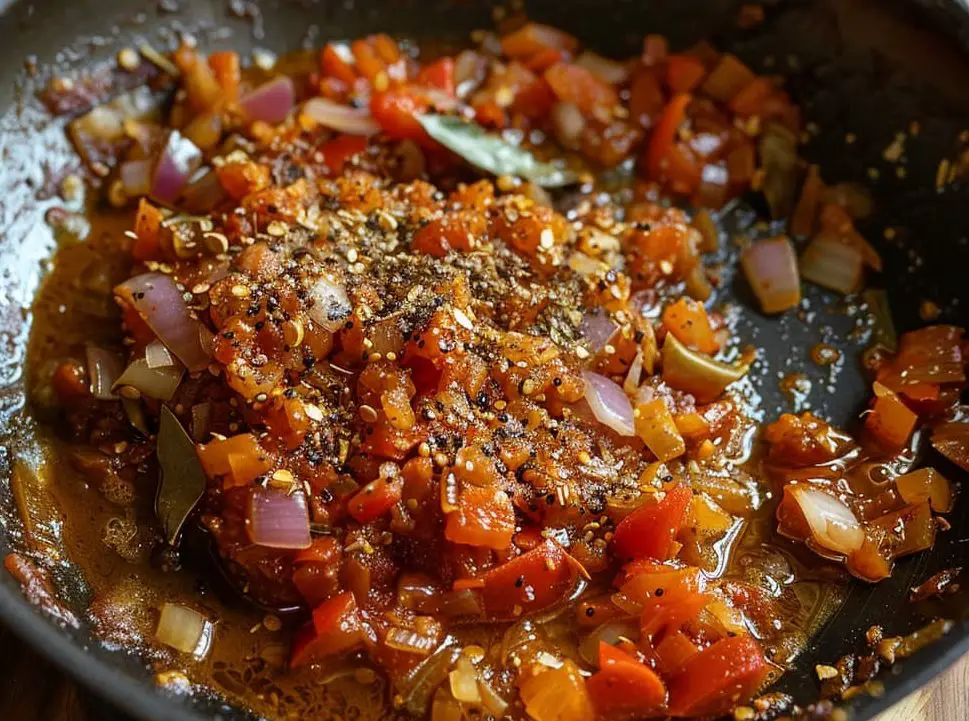
- Let the mixture simmer on low heat for 10-15 minutes, stirring occasionally. The tomatoes break down and meld with the spices, forming the perfect masala sauce.
Chickpeas Dive In:
-
- Add the chickpeas to the sauce, mixing well to ensure they’re fully coated.

- This step is crucial; it’s where the chickpeas absorb the masala, becoming the star of the dish.
Creamy Transformation:
-
- Slowly stir in the coconut milk (or dairy cream), bringing the sauce to a gentle simmer.
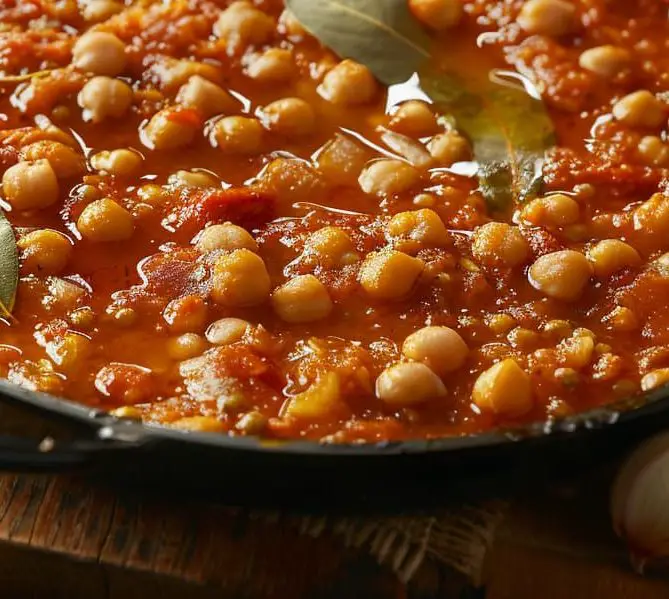
- Let it cook for another 10 minutes, adjusting the heat as needed. The sauce will thicken slightly, enveloping the chickpeas in creamy goodness.
Taste Test:
-
- Taste your creation, adjusting the salt or chili as you see fit.
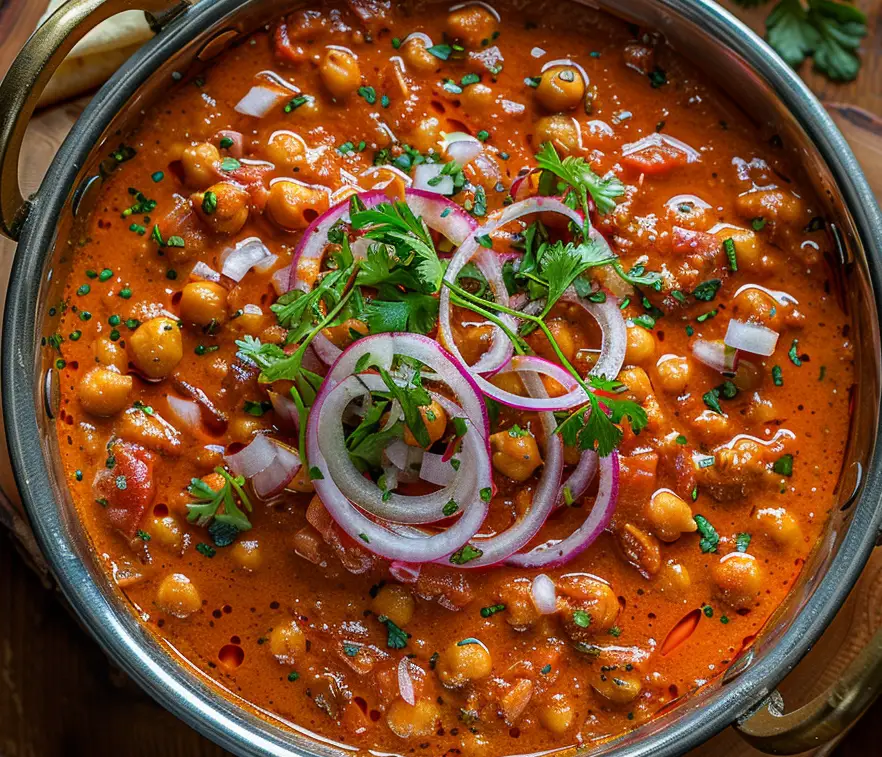
Garnish and Serve:
-
- Sprinkle chopped cilantro and and onion rings over the top for a burst of freshness.
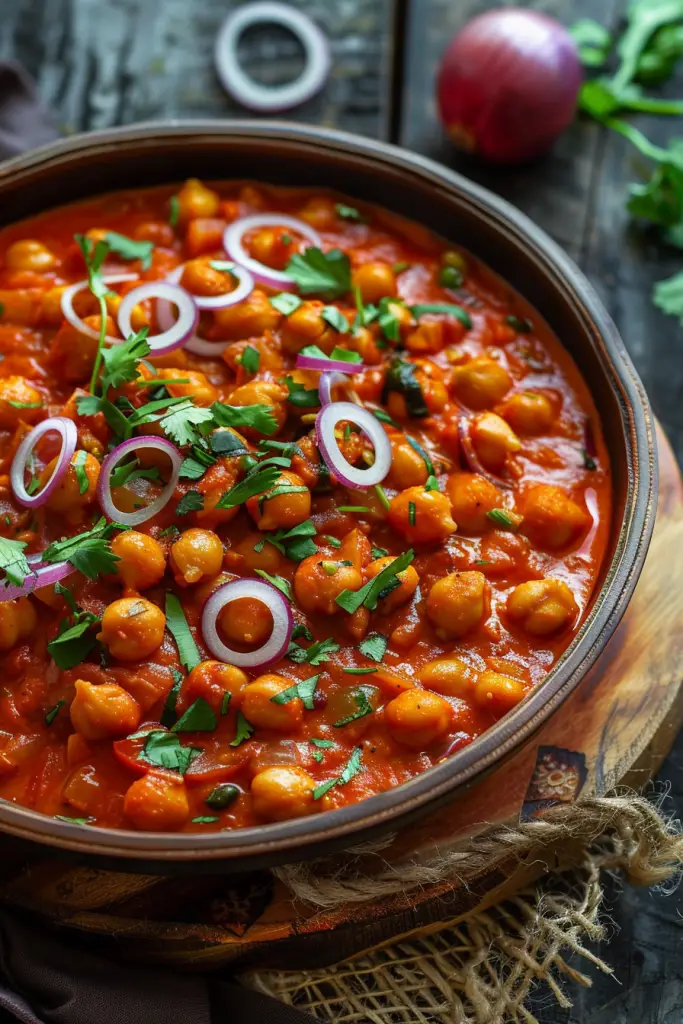
- Serve your Chickpea Tikka Masala hot, alongside rice or warm naan bread, with lemon wedges on the side for that extra zest.
Customization Tips
You can easily adapt it to include your favorite veggies, such as spinach, bell peppers, or even tofu, making it a perfect fit for different dietary preferences or meal times.
- In India, Chickpea Tikka Masala might lean more heavily on traditional spice blends, incorporating regional ingredients like fenugreek leaves or mustard oil for a deeper flavor profile.
- In the UK, the dish often has a creamier sauce, sometimes incorporating dairy or dairy-free alternatives to suit a wider range of dietary needs, reflecting its multicultural culinary landscape.
- In the US, variations might include additional vegetables or even a fusion of cuisines, incorporating elements like avocado or quinoa for a unique twist.
Mistakes To Avoid While Making Chickpea Tikka Masala
Ingredient Selection:
- Common Error: Using old spices. Spices lose potency over time, leading to a less flavorful dish.
- Solution: Always use fresh, high-quality spices. Consider grinding your own spice blends for the best flavor profile.
- Common Error: Opting for low-fat coconut milk. This can result in a less creamy sauce.
- Solution: Use full-fat coconut milk for a rich, authentic texture. If you’re watching fat intake, balance it by serving smaller portions.
Preparation Pitfalls:
- Common Error: Not properly preparing chickpeas. If using dried chickpeas, failing to soak or cook them adequately can result in a hard, unpalatable texture.
- Solution: Soak dried chickpeas overnight and cook them until tender before adding to the masala. If in a rush, canned chickpeas are a convenient and effective substitute but always wash them thoroughly before usage.
Cooking Techniques:
- Common Error: Overcooking the spices. This can make them bitter and overpowering.
- Solution: Cook spices on medium heat just until they release their aroma, usually no more than a minute. This method preserves their flavors and prevents bitterness.
- Common Error: Rushing the simmering process. The sauce needs time to develop depth.
- Solution: Allow the masala sauce to simmer gently, giving the flavors time to meld together. Patience is key for a well-rounded dish.
Seasoning and Flavoring:
- Common Error: Underseasoning. Chickpeas can be bland on their own and need adequate seasoning.
- Solution: Be generous with spices, and don’t forget to season with salt towards the end of cooking. Taste and adjust as necessary.
- Common Error: Adding lemon juice too early. Acidic ingredients can become bitter if cooked too long.
- Solution: Stir in lemon juice off the heat or just before serving to maintain its bright, fresh flavor.
Pairing Suggestions for Chickpea Tikka Masala
Beverages:
- Summer & Spring: A cool, refreshing mango lassi or cucumber mint water complements the spices well.
- Fall & Winter: Warm spiced chai tea or golden milk (turmeric latte) offers a cozy accompaniment.
Side Dishes:
- Basmati Rice: A staple that pairs well in any season, absorbing the rich flavors of the masala.
- Naan (Bread): Perfect for scooping up the sauce; try garlic naan for extra flavor.
- Cucumber Raita: Offers a cool, creamy counterpoint to the dish’s warmth and spice.
- Roasted Vegetables: Seasonal veggies like squash in fall or asparagus in spring make a nutritious side.
- Mango Chutney: A sweet and tangy mango chutney can add a delightful contrast to the flavors, introducing a bit of sweetness that complements the savory elements of the meal.
Main Courses:
- Grilled Tandoori Chicken: For a non-vegetarian option, this adds variety for mixed-diet families.
- Paneer Butter Masala: A vegetarian alternative that complements the chickpea dish for a fuller spread.
Seasonal Variation for Chickpea Tikka Masala
Spring:
- Incorporate fresh peas or asparagus to introduce a crisp, sweet element.
- Use lighter coconut milk to keep the dish refreshing.
Summer:
- Mix in fresh spinach or kale at the end of cooking for a vibrant, summery touch.
- Serve with a side of chilled cucumber salad to cool down the palate.
Fall:
- Introduce roasted pumpkin or sweet potatoes for a hearty, autumnal twist.
- Experiment with richer spices like clove or cinnamon for a warm, comforting flavor.
Winter:
- Add root vegetables like carrots or parsnips, which are in season and add depth.
- Consider using dried fenugreek leaves (kasuri methi) for a more robust, wintry flavor profile. But be wary of its quantity as too much of this spice can make the whole preparation taste bitter.
Always Keep In Mind, that the inclusion of newer veggies or spices can end up impacting the overall taste of the dish, so you may need to adjust your other spices or salt portions to counter that.
Common Problems You May Face While Cooking Chickpea Tikka Masala
Canned OR Raw
Problem: You’re unsure whether to use dried or canned chickpeas.
Solution: Canned chickpeas are a time-saver and perfect for beginners. Wash them rigorously with water to get rid of the excess salt and preservatives. If you opt for dried chickpeas, remember to soak them overnight and cook them until tender before adding them to the masala. Both methods are great; the choice depends on your time and preference.
Sauce Consistency Troubles
Problem: Your masala sauce is either too thick or too runny.
Solution: If the sauce is too thick, gently stir in a bit more water or coconut milk until you reach your desired consistency. If it’s too runny, let it simmer a bit longer to reduce and thicken. Achieving the perfect sauce consistency is all about adjusting as you go.
Achieving Perfectly Cooked Rice
Problem: Cooking basmati rice can sometimes end in a sticky situation.
Solution: Rinse the rice under cold water until the water runs clear to remove excess starch. Then, use a 1:2 ratio of rice to water, bring to a boil, cover, and simmer on low heat for about 15 minutes. Let it sit covered for another 5-10 minutes off the heat before fluffing with a fork.
Balancing Flavors
Problem: Your dish tastes too spicy, salty, or bland.
Solution: If it’s too spicy, add a dollop of yogurt or coconut cream to mellow the heat. Too salty? Add a squeeze of lemon juice or a bit more coconut milk. If it’s bland, a pinch more salt or a sprinkle of garam masala can elevate the flavors.
Tips for Perfecting Chickpea Tikka Masala
- Toast Your Spices: Before adding them to the dish, lightly toast the spices in a dry pan for a few seconds until aromatic. This simple step enhances their flavors, bringing a deeper dimension to your masala.
- Use Quality Coconut Milk: For the creamiest, richest sauce, opt for full-fat coconut milk. The quality of the coconut milk can significantly impact the dish’s texture and taste.
- Fresh vs. Canned Chickpeas: While canned chickpeas are convenient, cooking dried chickpeas from scratch can offer a fresher taste and better texture. Soak them overnight and cook until tender before using
FAQs about Chickpea Tikka Masala (Reader Questions Answered)
Can I make Chickpea Tikka Masala in advance?
- Solution: Yes, it actually tastes better the next day as the flavors have more time to meld. Store it in an airtight container in the fridge. Reheat gently on the stove or in the microwave.
Q: What if I don’t have garam masala?
- Solution: Garam masala is a blend of ground spices. While unique, you can substitute it with a mix of cumin, coriander, cardamom, and cinnamon powder. Start with small amounts and adjust to taste.
Q: How can I thicken the sauce without compromising the flavor?
- Solution: Letting the sauce simmer uncovered will naturally reduce and thicken it. Alternatively, a slurry of cornstarch and water can be added, but use sparingly to avoid altering the taste.
Q: Is there a way to make Chickpea Tikka Masala less spicy without losing its essence?
- Solution: Reduce the amount of chili powder or use a milder paprika. You can also increase the coconut milk quantity to mellow down the heat while maintaining the flavors.
Can I use a different type of bean if I don’t have chickpeas?
- Solution: Absolutely. While chickpeas are traditional, you can substitute them with other beans such as kidney beans or black beans for a different twist. Just ensure they are properly cooked before adding them to the masala.
Is there a way to make this dish in a slow cooker?
- Solution: Yes, you can make Chickpea Tikka Masala in a slow cooker. Prepare the onion, garlic, ginger, and spices as instructed, then transfer them to the slow cooker with the tomatoes, chickpeas, and coconut milk. Cook on low for 6-8 hours or on high for 3-4 hours.
What if I don’t have coconut milk?
- Solution: If you don’t have coconut milk, you can substitute it with other creamy elements like heavy cream (for non-vegans), almond milk, or cashew cream. Each will alter the flavor slightly but still contribute to the creamy texture of the dish.
Can I add vegetables to this dish?
- Solution: Yes, adding vegetables can make this dish even more nutritious. Consider stirring in spinach, bell peppers, or peas towards the end of cooking. They don’t need long to cook and will add color and variety to the meal.
Is it possible to make this recipe gluten-free?
- Solution: Chickpea Tikka Masala is naturally gluten-free. However, ensure that all packaged ingredients like garam masala are certified gluten-free. Serve with gluten-free naan or over a bed of rice for a complete meal.
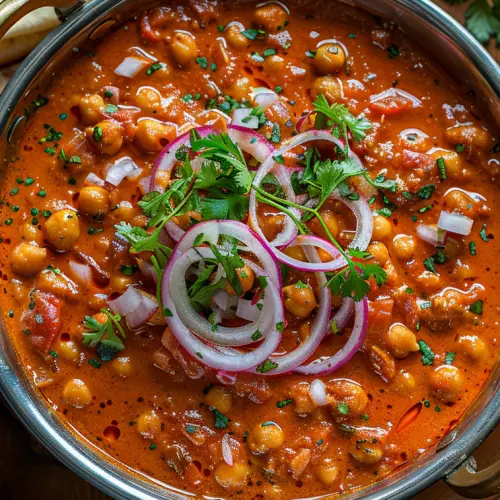
Chickpea Tikka Masala Recipe
Ingredients
Chickpeas:
- 200 g about 1 cup dried chickpeas (Alternative: soak and cook 400-425 g chickpeas for the equivalent of 2 cans (15 oz each) chickpeas)
Spice Base:
- 30 ml 2 tablespoons olive oil (Alternative: any vegetable oil)
- 1 large onion finely chopped (about 150 g)
- 3 cloves garlic minced (about 9 g)
- 2.5 cm 1 inch ginger, grated (about 10 g)
- 400 g about 14 oz fresh tomatoes, pureed (Alternative: 1 can (14 oz) crushed tomatoes)
- 400 ml about 14 oz full-fat coconut milk (Alternative: 400 ml dairy cream for non-vegan version; for a raw alternative, blend 200 g soaked raw cashews with water)
- 15 g 1 tablespoon garam masala
- 5 g 1 teaspoon turmeric powder
- 5 g 1 teaspoon cumin powder
- 2.5 g ½ teaspoon chili powder (Adjust to taste)
- Salt to taste start with 1 tsp and adjust
Garnish and Serving:
- Fresh cilantro chopped, for garnish
- Lemon wedges for serving
- Rice or naan bread
Instructions
If Using Dried Chickpeas:
- Soak Overnight: Rinse the dried chickpeas under cold water to remove any debris. Then, soak them in a large bowl of water overnight.
- This is not just a step; it's a transformation, as the chickpeas absorb the water and begin to soften.
Cook the Chickpeas:
- Drain and rinse the soaked chickpeas. Transfer them to a large pot and cover them with fresh water, about 2 inches above the chickpeas.
- Bring to a boil, then reduce the heat and simmer for 1-2 hours, or until the chickpeas are tender. The journey from hard beans to soft, plump chickpeas is slow but rewarding. They're ready when you can easily mash them between your fingers.
- Once the chickpeas are cooked and tender, drain them and set them aside.
Prep the Base:
- Heat oil in a large pan over medium heat.
- Add the chopped onion, sautéing until it turns translucent and slightly golden. This is where the foundation of flavor begins.
Aromatics Unleashed:
- Stir in minced garlic and grated ginger to the onion mixture.
- Sauté for another minute until the aroma fills your kitchen.
Spice Symphony:
- Sprinkle in the garam masala, turmeric, cumin, and chili powder.
- Stir continuously for about 30 seconds. Toasting the spices this way releases their oils, magnifying their flavors and marrying them beautifully with the aromatics.
Simmering the Sauce:
- Pour in the crushed tomatoes and add salt.
- Let the mixture simmer on low heat for 10-15 minutes, stirring occasionally. The tomatoes break down and meld with the spices, forming the perfect masala sauce.
Chickpeas Dive In:
- Add the chickpeas to the sauce, mixing well to ensure they're fully coated.
- This step is crucial; it's where the chickpeas absorb the masala, becoming the star of the dish.
Creamy Transformation:
- Slowly stir in the coconut milk (or dairy cream), bringing the sauce to a gentle simmer.
- Let it cook for another 10 minutes, adjusting the heat as needed. The sauce will thicken slightly, enveloping the chickpeas in creamy goodness.
Taste Test:
- Taste your creation, adjusting the salt or chili as you see fit.
Garnish and Serve:
- Sprinkle chopped cilantro and onion rings over the top for a burst of freshness.
- Serve your Chickpea Tikka Masala hot, alongside rice or warm naan bread, with lemon wedges on the side for that extra zest.
I hope this recipe becomes more than just a meal for you – perhaps a memory, an adventure, or even a new favorite.
I’m eager to hear about your experiences with this recipe. Did you add your own twist? How did it turn out? Your feedback is not just welcomed; it’s essential. It helps us all grow and connect through our shared love of food.
If you have any queries let me know, I can add them in the FAQs portion of this article.
So, please, share your stories, questions, or variations in the comments below.

